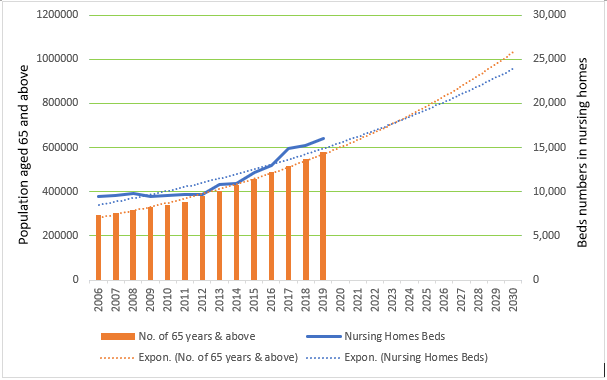Singapore is a highly dense cityscape with a population of 5.7 million in 2020, with around 580,000 citizens aged 65 and above. The population will grow to 6.5 million people in 2030, and among this, there will be 900,000 citizens aged 65 and above. The increase in population partly contributed by foreigners such as permanent residents, dependent pass holders, foreign workforce. (about 2.9 million).
Amongst the 590,000 seniors today, 67.3% are young-old, 24.1% are middle-old and 8.6% are old-old. In 2030, the young-old will decrease to 60.2%, middle-ole will grow to 31.8% and old-old will become 8.0%.

| Year | Beds |
|---|---|
| 2012 | 9721 |
| 2014 | 10968 |
| 2017 | 14918 |
| 2018 | 15205 |
| 2019 | 16059 |
| 2020 | 17000 |
To cope with the aging population, Singapore government has been building more and more eldercare facilities to cater the rising demand. Among which, building more community care, home care and nursing home facilities. The table on the left shows the number of nursing home beds from 2012 to 2019 (extracted from MOH), while 2020 is a projected figure. At the time of writing this article, there was no projection available on nursing home beds for 2030.
From extrapolation, by 2030, the population of 65 years old and above is 900,000. The chart shows that population of age 65 and above could grow up to 1,000,000 in 2030, while the number of beds in nursing home may increase to 24,000 beds as compared to 17,000 in 2020. However, the estimation above has not factored in mortality rate and life expectancy. Once all these being factored in, the figure will be more realistic.


